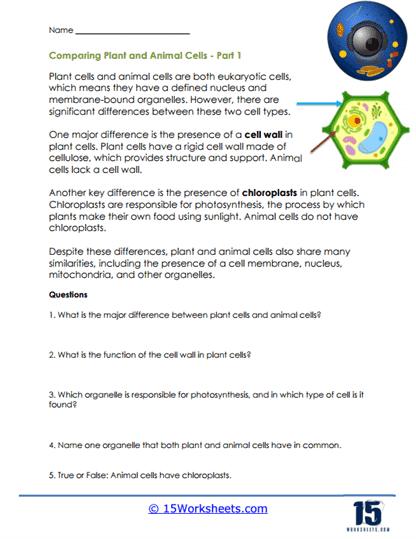Plant vs. Animal Cells

Worksheet Description
This worksheet provides a comparative analysis between plant and animal cells, emphasizing their similarities and distinctions. While both cell types are classified as eukaryotic and possess membrane-bound organelles, the worksheet spotlights specific differences such as the presence of a cell wall and chloroplasts in plant cells, which are absent in animal cells. It also notes that despite these variations, plant and animal cells share numerous common features, including a cell membrane, nucleus, mitochondria, and other organelles. The accompanying questions are structured to test comprehension and highlight these key cellular differences and similarities.
To successfully tackle this worksheet, students should begin by reading the provided content diligently to grasp the fundamental differences and similarities between plant and animal cells. Once they comprehend the unique characteristics and shared features, they should proceed to the questions section. Each query can typically be answered by referencing specific parts of the introductory text, making it crucial to read and refer back as needed. This approach of initial comprehension followed by application to answer the questions will ensure a thorough understanding of the topic.
The primary educational objective of this worksheet is to familiarize students with the intrinsic differences and shared traits between plant and animal cells. By laying out the defining characteristics of each cell type, such as the presence of cell walls and chloroplasts in plant cells, the worksheet offers a clear understanding of what sets these cells apart. However, by also pointing out shared organelles, it underscores the foundational similarities between them. In essence, the worksheet seeks to cultivate a balanced perspective on cell biology, enabling students to differentiate and appreciate the cellular intricacies of both plant and animal cells.
